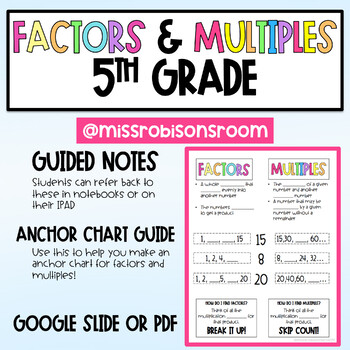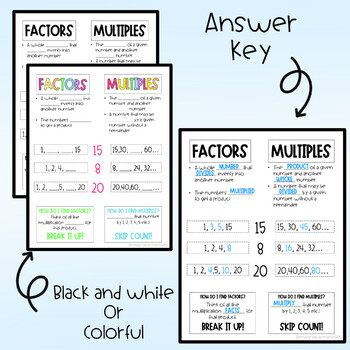Factors and Multiples Guided Notes/Anchor Chart Planning (PDF or GOOGLE SLIDE)
10,464 Downloads
Miss Robison's Room
239 Followers
Grade Levels
4th - 6th
Subjects
Resource Type
Standards
CCSS5.NBT.B.5
CCSS4.OA.B.4
CCSS6.NS.B.4
CCSS6.EE.A.2b
Formats Included
- PDF
Miss Robison's Room
239 Followers
Description
This resource can be used in the math classroom in different ways
- guided notes while teaching a mini-lesson about the vocabulary of factors and multiples
- a plan for an anchor chart for your mini-lesson
- mini anchor charts that can be glued into math notebooks for students to refer back to when this topic spirals back in
- mini anchor charts that can be saved on student devices to refer back to when this topic spirals back in
Total Pages
Answer Key
N/A
Teaching Duration
N/A
Report this resource to TPT
Reported resources will be reviewed by our team. Report this resource to let us know if this resource violates TPT’s content guidelines.
Standards
to see state-specific standards (only available in the US).
CCSS5.NBT.B.5
Fluently multiply multi-digit whole numbers using the standard algorithm.
CCSS4.OA.B.4
Find all factor pairs for a whole number in the range 1-100. Recognize that a whole number is a multiple of each of its factors. Determine whether a given whole number in the range 1-100 is a multiple of a given one-digit number. Determine whether a given whole number in the range 1-100 is prime or composite.
CCSS6.NS.B.4
Find the greatest common factor of two whole numbers less than or equal to 100 and the least common multiple of two whole numbers less than or equal to 12. Use the distributive property to express a sum of two whole numbers 1–100 with a common factor as a multiple of a sum of two whole numbers with no common factor. For example, express 36 + 8 as 4 (9 + 2).
CCSS6.EE.A.2b
Identify parts of an expression using mathematical terms (sum, term, product, factor, quotient, coefficient); view one or more parts of an expression as a single entity. For example, describe the expression 2 (8 + 7) as a product of two factors; view (8 + 7) as both a single entity and a sum of two terms.



